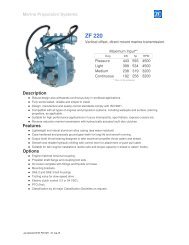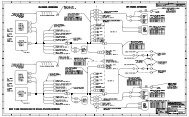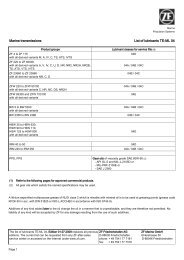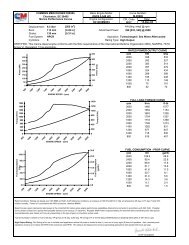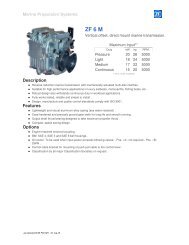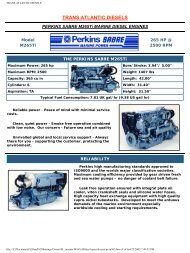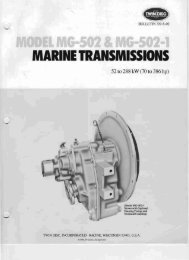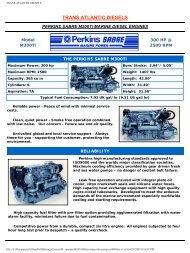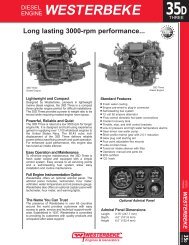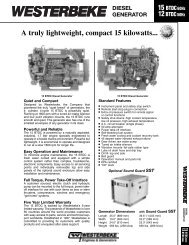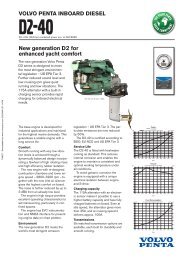Balmar Product Guide
Balmar Product Guide
Balmar Product Guide
You also want an ePaper? Increase the reach of your titles
YUMPU automatically turns print PDFs into web optimized ePapers that Google loves.
SELECTING YOUR CHARGING SYSTEMBATTERY Technology (continued)As a result, these newer battery types MUST be charged with a large case or extra-large case alternatordue to their nearly limitless demands. <strong>Balmar</strong> has responded to the unique needs of these new batterytechnologies with a Lithium-ready alternator/regulator combination (see rear cover) that’s designed to meetthe needs of these new batteries.BATTERY CapacityIn addition to battery technology, battery bank capacity has a dramatic impact on the size and type of alternator requiredto keep the batteries healthy. House battery capacity is usually calculated based on the ability to meet approximatelythree day’s worth of typical demand -- or more, if the vessel is unlikely to be plugged into shorepower charging forextended periods.Typical DC Electrical LoadsThe chart at right provides typical DC marine loads. Accurate load calculations(Shown In Amps Per Hour)require precise measurement of your vessel’s equipment. Refer to equipmentVHF Receive 1.5manuals for actual load ratings, or consult with a qualified marine electrician toVHF Transmit 5.0determine your actual needs. Keep in mind that every 100 amps of discharge willCB Receive 1.0require 115 amps of charging current to replenish.CB Transmit 5.0In most cases, your alternator’s output should be equal to the maximum availableSSB Receive 1.5capacity of your battery bank. In other words, if your house battery bank is madeSSB Transmit 25.0up of deep-cycle flooded batteries with a capacity rating of 400 amp/hours, theDepth Finder 1.0maximum acceptance rate of those batteries would be approximately 25 percent,GPS .50or 100 amps. The ideal alternator would also be rated at 100 amps. On the otherhand, if your house bank consists of 400 amp/hour capacity AGM batteries, themaximum available capacity would be approximately 45 percent of 400, or roughly180 amp hours. To maximize charging efficiency, a 180-amp rated alternator wouldbe required. Unfortunately, in many vessels, mounting a large-case alternator is notfeasible.Limitations On AlTERNATOR OutputThe size and type of alternator drive belt may limit the rated output of the alternatoryou choose. If your battery capacity is substantially larger than the output allowedbased on belt size, it may be necessary to reduce loads in order to lessen therequired battery capacity, or it may be necessary to modify the engine pulleysystem to allow the use of a larger belt, or multiple belts to drive the alternator.Many boaters have found that adding a second alternator to their engine providesan excellent solution for charging large battery banks, and several companiesoffer bracket and pulley sets to support second alternator installations. <strong>Balmar</strong>’sMax Charge voltage regulators offer sufficient field output capability to control twoalternators at once. <strong>Balmar</strong>’s new MC-612-DUAL multi-stage regulator has two fieldoutput terminals and temperature sensing for two alternators, making it the perfectcharge control solution for a single-engine, dual-alternator application. See ourwebsite (www.balmar.net) for more information.In twin engine applications, <strong>Balmar</strong>’s Centerfielder II offers an excellent solutionfor balanced charge control over dualalternators. By monitoring port andstarboard alternators and regulators, andRadarVideo SounderWeather FaxLaptop ComputerAuto PilotKnot MeterWind SpeedAnchor LightSteaming LightRunning LightStrobeTricolorBilge PumpHeadWash Down PumpRefrigeratorHand SpotlightSpreader LightSmall TVLarge TVDVD PlayerSatellite Receiver4.04.02.56.04.0.10.101.01.03.0.752.05.050.010.05-1010.08.08.025.08.012.0controlling field output to both alternators, the Centerfielder II makes it possibleto direct the combined output from both alternators to charge a central housebattery bank.Please note: when using the Centerfielder II in any twin engineapplication, it is essential that it is used in conjunction with Max ChargeMC-614 or MC-624 regulators only. DO NOT use MC-614 regulators witholder Centerfielder units.Visit us online at WWW.BALMAR.NET– 5 –




